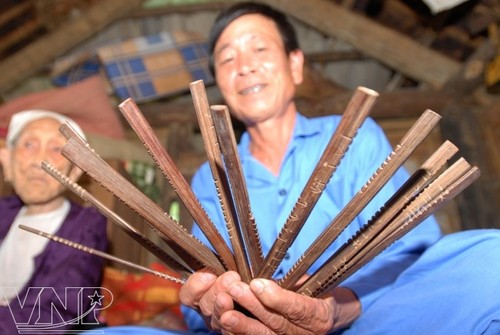(VOVworld) – The Doi calendar, which once was used by all Muong branches, is now used only by shamans of the Muong Bi in Tan Lac district, Hoa Binh province.
Shaman Bui Van Khan of the Muong Bi is selecting a good day for Bui Van Tuyen to build a new house. Khan says only the Muong Bi people are using the Doi or bamboo calendar. For many generations, the Muong Bi have carefully chosen good days to organize important events such as weddings. Khan says: “
Branches of the Muong have the same way to celebrate the New Year, the same production methods, and two crops a year. We use the Doi calendar which has 12 sticks representing the 12 months.”
.jpg) |
| 12-stick Doi calendar (photo: mytour.vn) |
A Doi stick is about 20 cm long and has 30 lines representing 30 days. The Doi calendar follows the movement of the Pleiades stars and the moon. Bui Van Huong elaborates: “A month has 30 days. The new moon is called Cay, the full moon day is called Lom, and moonset is called Coi.”
The experienced shamans climb Cot Co mountain and stand in a large open area to observe the Pleiades stars to forecast droughts and rain. The 30 lines on the Doi stick vary – short or long lines with arrows, ticks, and dots to indicate good and bad days and the weather. Khan says: “Good and bad days, profitable and unprofitable days, are marked on the sticks. We consult the Doi calendar to build a house, plant a new crop or harvest. Other Muong branches now follow the lunar calendar of the Kinh. A good day on the Kinh calendar might be a bad day for the Muong.”

Shaman Bui Van Eu in Hoa Binh province introduces his family's Doi calendar |
Khan said he has always referred to the Doi calendar to help the villagers select a good day to do business or hold a funeral or a wedding. The Muong use the Gregorian calendar for state administrative activities. Bui Van Tuyen says young people like him cannot read the Doi calendar.
“I don’t understand the Doi calendar. Maybe I will learn it when I’m 35 or 40 years old. Whenever I do anything, I ask old people to consult the Muong calendar. A good day on the Gregorian calendar might not be a good day for the Muong.” Tuyen said.
The Muong characterize their lifestyle as steamed rice, stilt houses, water carried on the shoulder, roasted pigs, and late dates. The Muong calendar is 15 days later than the lunar calendar. Every year they welcome the Lunar New Year first and the New Year of the Doi calendar 15 days later. The Doi calendar embodies the astronomical knowledge of the ancient Muongs.